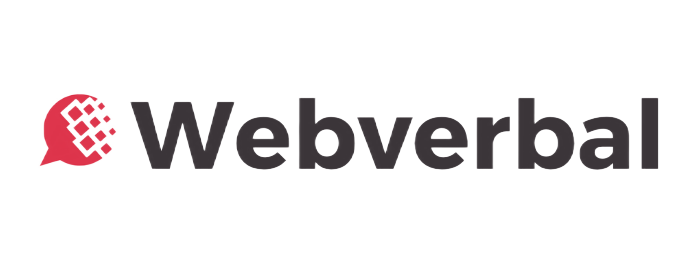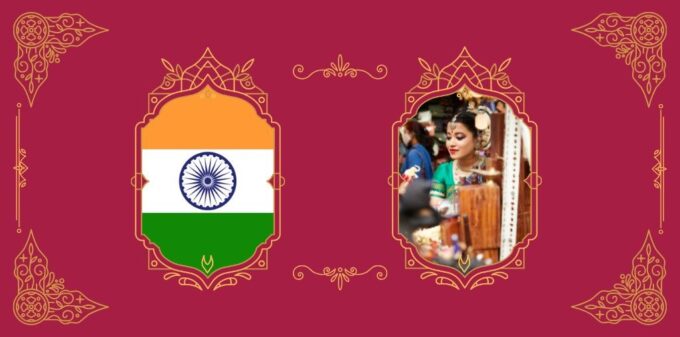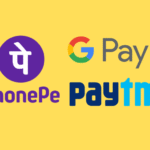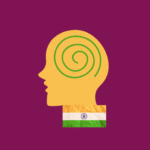Table Of Content
- The Great Indian Consumer Enigma
- 1: The Cultural Foundation of Indian Consumer Psychology
- 1.1 The Hierarchy of Values System
- 1.2 The Trust Ecosystem
- 2: The Digital Transformation of Indian Consumer Mindset
- 2.1 The Great Digital Leap
- 2.2 Generational Psychology Shifts
- 3: Economic Psychology and Spending Behaviors
- 3.1 The Income-Aspiration Gap
- 3.2 The Savings vs. Spending Dilemma
- 4: Regional Psychology Variations
- 4.1 The North-South Consumer Divide
- 4.2 Urban vs. Rural Psychology Dynamics
- 5: The Psychology of Indian Digital Commerce
- 5.1 Trust Building in Digital Transactions
- 5.2 Mobile-First Psychology
- 6: Cultural Triggers and Purchase Psychology
- 6.1 Festival Commerce Psychology
- 6.2 Astrology and Consumer Decisions
- 7:The Psychology of Brand Loyalty and Switching
- 7.1 Loyalty Patterns Across Categories
- 7.2 Switching Psychology Triggers
- 8: Emotional Psychology in Indian Consumer Behavior
- 8.1 The Emotional Purchase Framework
- 8.2 Color Psychology and Cultural Associations
- 9: The Future of Indian Consumer Psychology
- 9.1 Emerging Psychological Trends
- 9.2 Technology Integration Psychology
- 10: Practical Applications for Brands
- 10.1 Psychological Segmentation Strategies
- 10.2 Cultural Integration Strategies
- Data Sources and Methodology
- Conclusion: Mastering the Art of Indian Consumer Psychology
- Frequently Asked Questions
As a mentor for change working closely with NITI Aayog’s Atal Tinkering labs, I’ve witnessed firsthand how deeply cultural nuances shape India’s consumer landscape. This comprehensive analysis draws from extensive research, government data, and ground-level insights to decode the intricate psychology that drives 1.4 billion consumers.
The Great Indian Consumer Enigma
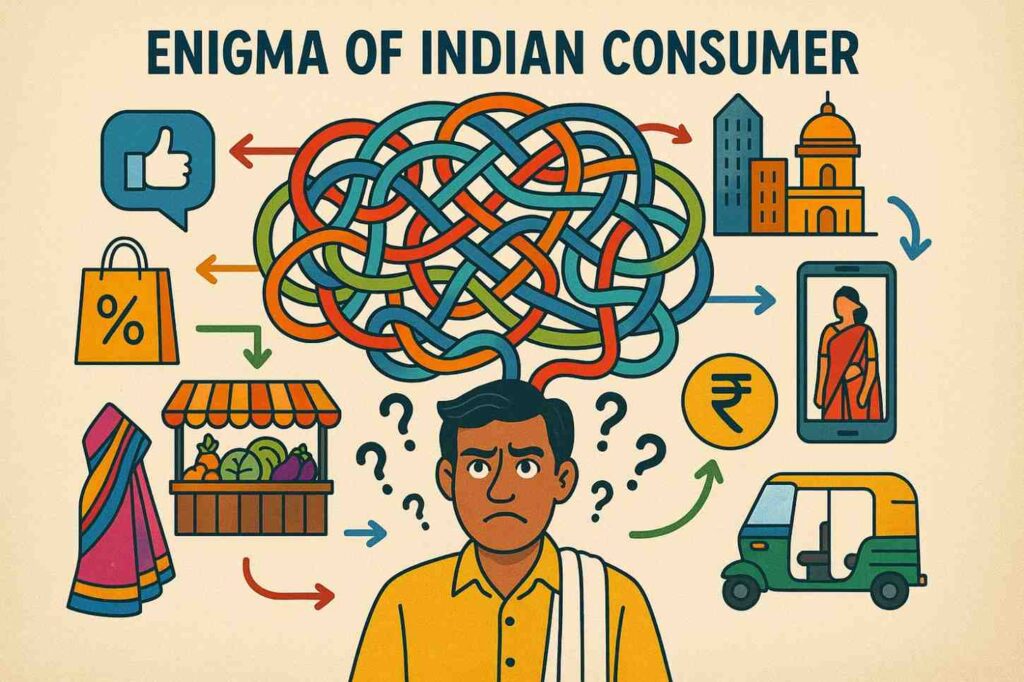
Indian consumer psychology represents one of the world’s most fascinating and complex behavioral ecosystems. With over 1.4 billion consumers spanning 28 states, 8 union territories, and representing 22 official languages, understanding this market requires deep cultural intelligence combined with data-driven insights.
Recent studies by McKinsey Global Institute reveal that India’s consumer spending is projected to grow from $1.5 trillion in 2021 to $6 trillion by 2030, making it the world’s third-largest consumer market. However, this growth story isn’t just about numbers—it’s about understanding the psychological triggers that drive purchase decisions across diverse demographic segments.
Want to go deeper? Read our full pillar article on Consumer Behaviour in India 2025: Trends, Insights & Strategies for Brands to understand the shifts shaping Indian buyers and how brands can stay ahead.
1: The Cultural Foundation of Indian Consumer Psychology
1.1 The Hierarchy of Values System
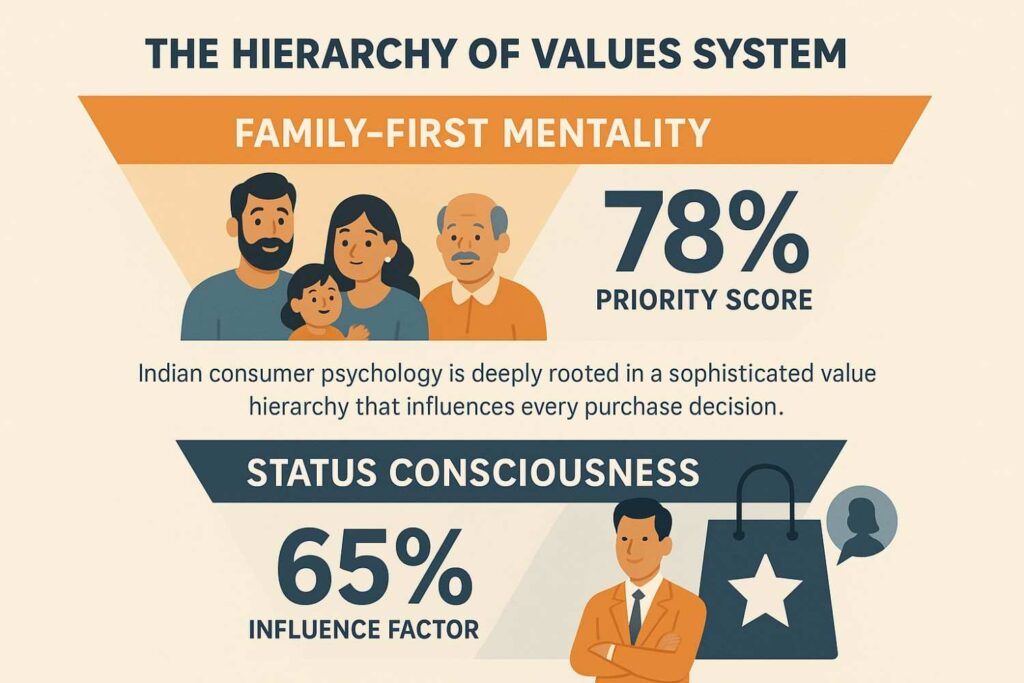
Indian consumer psychology is deeply rooted in a sophisticated value hierarchy that influences every purchase decision. According to research conducted by the Indian Institute of Management Ahmedabad (IIM-A), Indian consumers operate within a framework of:
Family-First Mentality (78% Priority Score) Data from the National Sample Survey Office (NSSO) indicates that 78% of Indian consumers consider family needs before personal desires. This psychological trait manifests in:
- Joint decision-making processes for major purchases
- Preference for products that benefit multiple family members
- Long-term value perception over immediate gratification
Status Consciousness (65% Influence Factor) Research by the Centre for Monitoring Indian Economy (CMIE) shows that status-conscious consumption drives 65% of discretionary spending decisions. This psychological driver includes:
- Brand preference for social signaling
- Aspirational consumption patterns
- Community validation seeking behavior
1.2 The Trust Ecosystem
Trust forms the cornerstone of Indian consumer psychology. A comprehensive study by the Trust Research Advisory and BCG revealed critical insights:
Relationship-Based Commerce (82% Preference)
- 82% of Indian consumers prefer buying from known vendors
- Word-of-mouth influences 74% of purchase decisions
- Community endorsement carries 3x more weight than celebrity endorsements
Institutional Trust Patterns According to Edelman Trust Barometer India 2024:
- Government institutions: 67% trust score
- Traditional businesses: 71% trust score
- Digital-first brands: 54% trust score
- Foreign brands: 58% trust score
2: The Digital Transformation of Indian Consumer Mindset
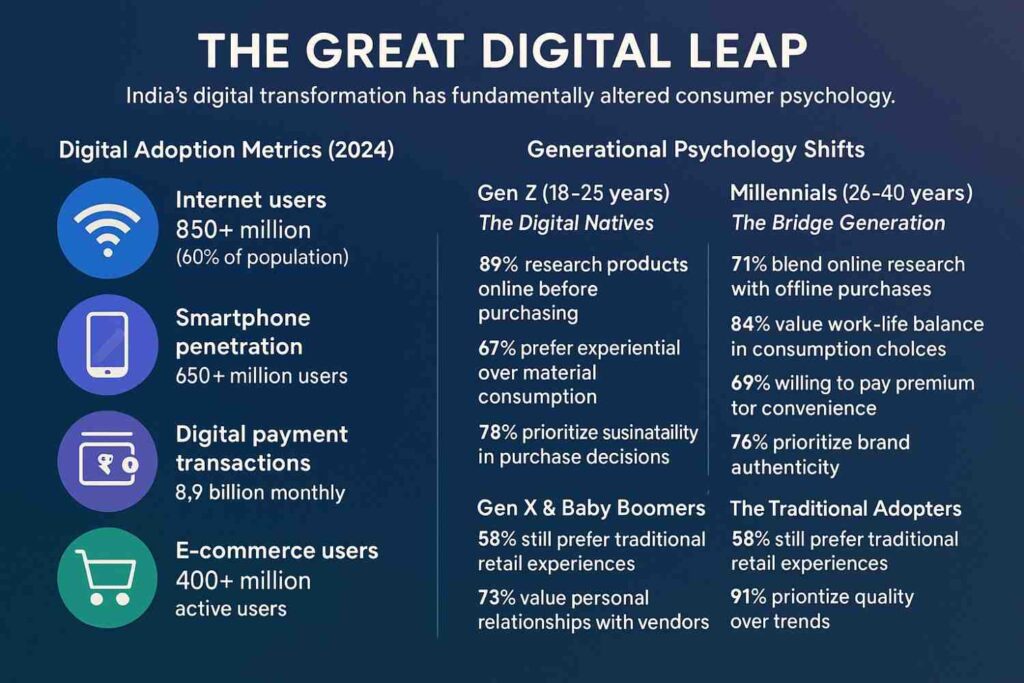
2.1 The Great Digital Leap
India’s digital transformation has fundamentally altered consumer psychology. Data from the Ministry of Electronics and Information Technology shows:
Digital Adoption Metrics (2024):
- Internet users: 850+ million (60% of population)
- Smartphone penetration: 650+ million users
- Digital payment transactions: 8.9 billion monthly (NPCI data)
- E-commerce users: 400+ million active users
2.2 Generational Psychology Shifts
Gen Z (18-25 years) – The Digital Natives Research by Bain & Company India identifies key psychological traits:
- 89% research products online before purchasing
- 67% prefer experiential over material consumption
- 78% prioritize sustainability in purchase decisions
- 82% influenced by social media recommendations
Millennials (26-40 years) – The Bridge Generation McKinsey’s India Consumer Survey reveals:
- 71% blend online research with offline purchases
- 84% value work-life balance in consumption choices
- 69% willing to pay premium for convenience
- 76% prioritize brand authenticity
Gen X & Baby Boomers (40+ years) – The Traditional Adopters Nielsen India’s Consumer Confidence Survey shows:
- 58% still prefer traditional retail experiences
- 73% value personal relationships with vendors
- 91% prioritize quality over trends
- 65% influenced by family recommendations
3: Economic Psychology and Spending Behaviors
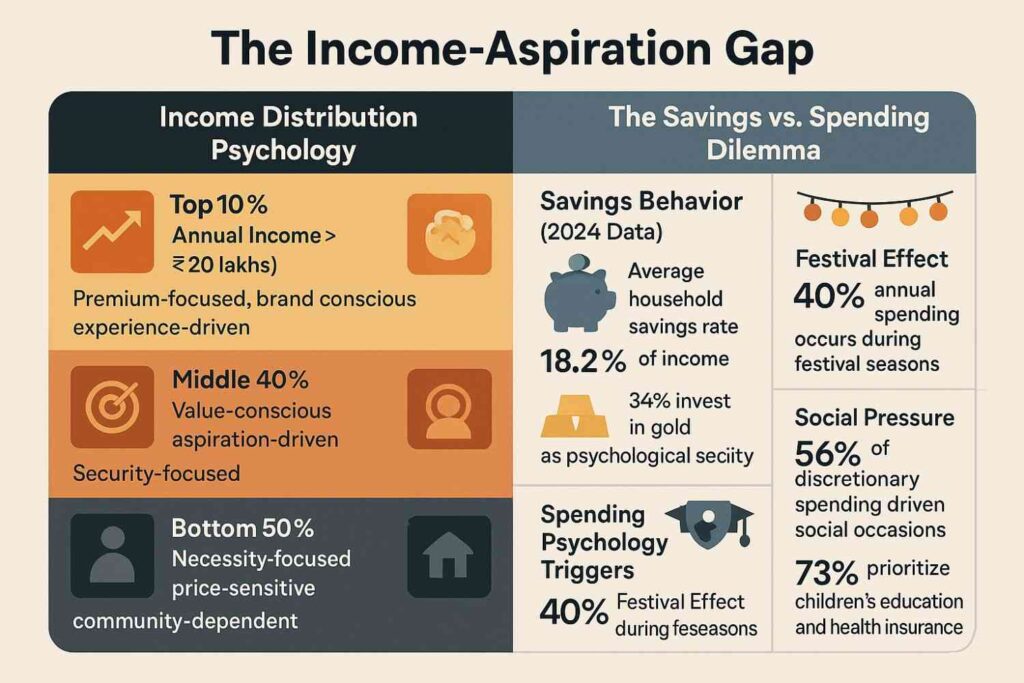
3.1 The Income-Aspiration Gap
India’s unique economic structure creates distinct psychological spending patterns. According to the Periodic Labour Force Survey (PLFS) 2023-24:
Income Distribution Psychology:
- Top 10% (Annual Income >₹20 lakhs): Premium-focused, brand conscious, experience-driven
- Middle 40% (Annual Income ₹2-20 lakhs): Value-conscious, aspiration-driven, security-focused
- Bottom 50% (Annual Income <₹2 lakhs): Necessity-focused, price-sensitive, community-dependent
3.2 The Savings vs. Spending Dilemma
Research by the Reserve Bank of India’s Household Finance Committee reveals fascinating psychological patterns:
Savings Behavior (2024 Data):
- Average household savings rate: 18.2% of income
- 67% prefer fixed deposits despite low returns
- 34% invest in gold as psychological security
- 28% participate in stock markets (up from 12% in 2019)
Spending Psychology Triggers:
- Festival Effect: 40% annual spending occurs during festival seasons
- Social Pressure: 56% of discretionary spending driven by social occasions
- Future Security: 73% prioritize children’s education and health insurance
4: Regional Psychology Variations
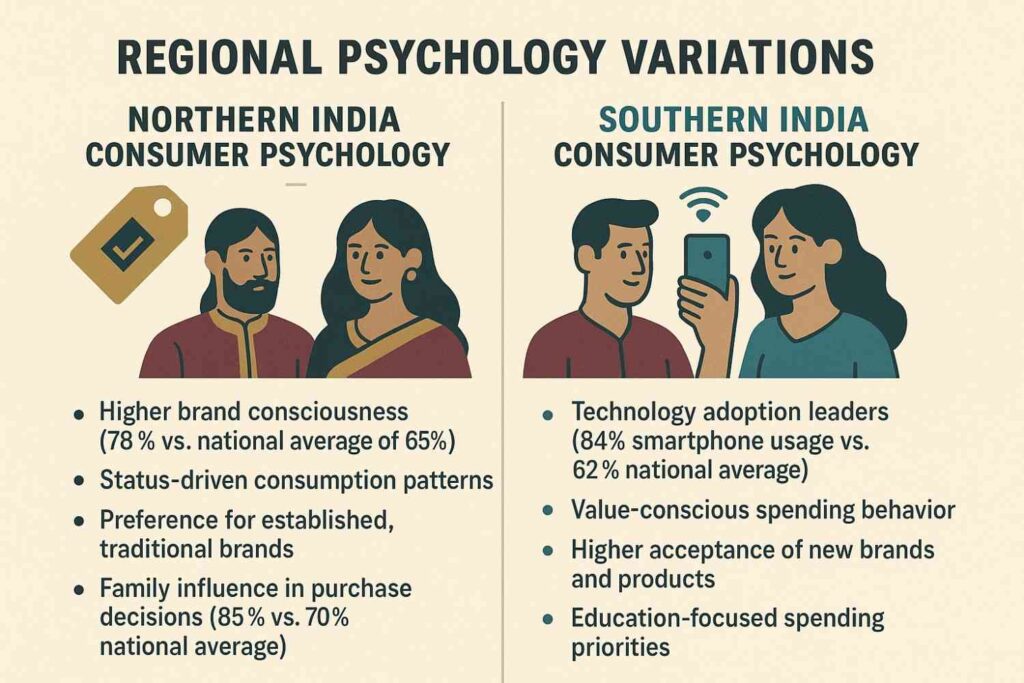
4.1 The North-South Consumer Divide
Extensive research by the Indian Council of Social Science Research identifies distinct regional psychological patterns:
Northern India Consumer Psychology:
- Higher brand consciousness (78% vs. national average of 65%)
- Status-driven consumption patterns
- Preference for established, traditional brands
- Family influence in purchase decisions (85% vs. 70% national average)
Southern India Consumer Psychology:
- Technology adoption leaders (84% smartphone usage vs. 62% national average)
- Value-conscious spending behavior
- Higher acceptance of new brands and products
- Education-focused spending priorities
Western India (Maharashtra, Gujarat) Psychology:
- Entrepreneurial mindset influences consumption
- Investment-oriented spending behavior
- Business-utility focused purchases
- Higher risk-taking in financial products
Eastern India Psychology:
- Cultural preservation influences buying decisions
- Community-centric consumption patterns
- Traditional product preferences
- Price-sensitive market behavior
Curious how regional hues influence buying habits? Explore North vs South vs East vs West: The Complete Map of Bharat’s Buying Psychology to discover how each zone approaches consumption – and what it means for your brand strategy.
(Link: North vs South vs East vs West: The Complete Map of Bharat’s Buying Psychology)
4.2 Urban vs. Rural Psychology Dynamics
Urban Consumer Psychology (34% of population, 52% of consumption): According to NSSO Consumer Expenditure Survey 2022-23:
- Convenience-driven purchases (78%)
- Time-saving product preferences (71%)
- Brand experimentation willingness (64%)
- Digital-first shopping approach (69%)
Rural Consumer Psychology (66% of population, 48% of consumption):
- Utility-focused buying decisions (89%)
- Community validation seeking (82%)
- Traditional retail preference (76%)
- Word-of-mouth dependency (91%)
5: The Psychology of Indian Digital Commerce
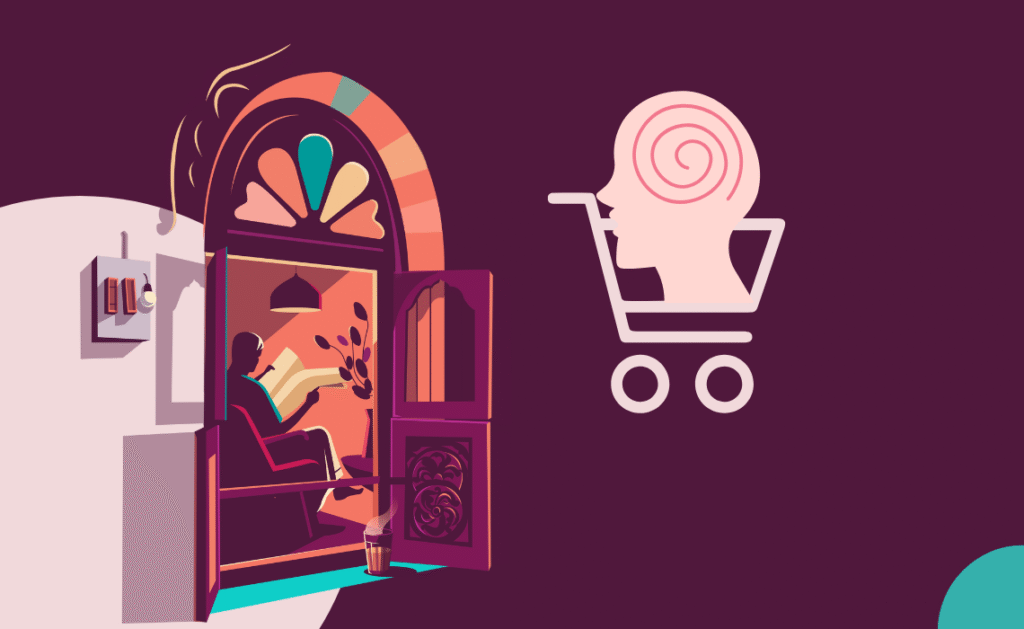
5.1 Trust Building in Digital Transactions
Research by the Digital India Corporation and PhonePe Pulse reveals critical psychological barriers and drivers:
Digital Trust Factors:
- Cash on Delivery preference: 68% of first-time online buyers
- Platform reputation influence: 84% purchase likelihood
- User reviews impact: 76% decision influence
- Return policy importance: 71% confidence factor
5.2 Mobile-First Psychology
India’s unique mobile-first digital journey creates distinct psychological patterns:
Mobile Commerce Psychology (Data from Google-BCG Study 2024):
- 87% research products on mobile devices
- 54% complete purchases on mobile
- 73% prefer app-based shopping over websites
- 81% influenced by personalized mobile notifications
6: Cultural Triggers and Purchase Psychology
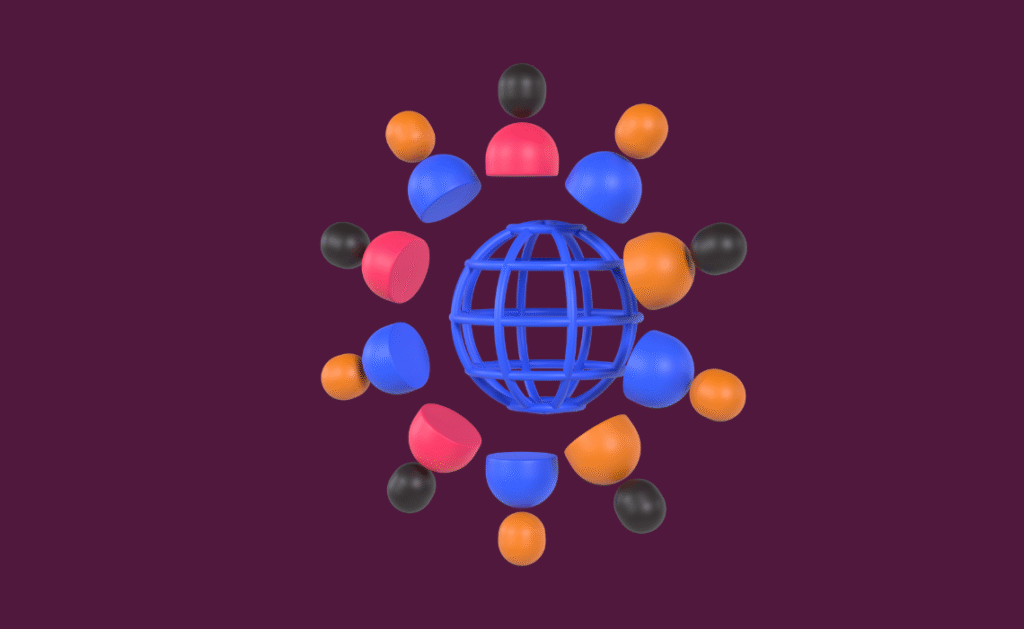
6.1 Festival Commerce Psychology
Indian festivals drive significant consumer behavior changes. Analysis of consumer spending data from various sources:
Festival Spending Patterns:
- Diwali: 35% of annual jewelry purchases, 28% of electronics
- Dussehra: 22% of vehicle purchases, 31% of home appliances
- Eid: 18% of fashion spending, 25% of food and gifting
- Regional festivals: 15% of local product purchases
6.2 Astrology and Consumer Decisions
A lesser-discussed but significant factor in Indian consumer psychology:
Astrological Influence on Purchases (Survey by Indian Astrology Research Institute):
- 34% consult astrologers for major purchases
- 67% avoid purchases during “inauspicious” periods
- 78% prefer “muhurat” shopping for gold and property
- 45% consider planetary positions for business investments
7:The Psychology of Brand Loyalty and Switching
7.1 Loyalty Patterns Across Categories
Research by Kantar India Brand Equity Survey 2024 reveals category-specific loyalty patterns:
High Loyalty Categories:
- Personal care products: 78% brand loyalty
- Telecom services: 71% despite competitive pricing
- Banking services: 84% (trust-dependent)
- Pharma products: 89% (doctor influence)
Low Loyalty Categories:
- Fashion and lifestyle: 34% loyalty
- Food delivery apps: 28% loyalty
- Electronics accessories: 31% loyalty
- Online retail platforms: 41% loyalty
7.2 Switching Psychology Triggers
Analysis of consumer switching behavior from multiple industry reports:
Primary Switching Triggers:
- Price sensitivity: 68% switch for 15%+ price difference
- Quality issues: 84% switch after negative experience
- Service problems: 76% switch due to poor customer service
- Social influence: 43% switch based on peer recommendations
- Convenience factors: 57% switch for better accessibility
8: Emotional Psychology in Indian Consumer Behavior
8.1 The Emotional Purchase Framework
Research by the Neuro-Marketing Research Institute, India, identifies key emotional triggers:
Primary Emotional Drivers:
- Security and Safety: 89% priority for financial products
- Family Pride: 76% influence on lifestyle purchases
- Social Acceptance: 64% driver for fashion and lifestyle
- Achievement Recognition: 71% influence on premium purchases
8.2 Color Psychology and Cultural Associations
Studies by the Indian Institute of Psychology reveal color preferences:
Cultural Color Psychology:
- Red: Auspiciousness, festivals (78% positive association)
- Saffron: Spirituality, tradition (71% trust factor)
- Green: Growth, prosperity (68% in financial products)
- Blue: Trust, reliability (82% in technology products)
- Gold: Prosperity, status (91% premium perception)
9: The Future of Indian Consumer Psychology
9.1 Emerging Psychological Trends
Based on longitudinal studies by IIM Bangalore and trend analysis:
Sustainability Consciousness:
- 67% willing to pay premium for sustainable products (up from 34% in 2019)
- 78% prefer brands with social responsibility initiatives
- 84% concerned about environmental impact
Health and Wellness Psychology:
- 89% prioritize health in purchase decisions post-COVID
- 76% prefer organic and natural products
- 82% willing to invest in preventive healthcare
9.2 Technology Integration Psychology
AI and Personalization Acceptance:
- 71% comfortable with AI-powered recommendations
- 64% appreciate personalized shopping experiences
- 58% willing to share data for better service
10: Practical Applications for Brands
10.1 Psychological Segmentation Strategies
Segment 1: Security Seekers (32% of market)
- Emphasis on trust, guarantee, and stability
- Long-term value propositions
- Family-oriented messaging
- Traditional communication channels
Segment 2: Status Aspirants (28% of market)
- Premium positioning and exclusivity
- Social media and influencer marketing
- Lifestyle integration strategies
- Peer validation mechanisms
Segment 3: Value Optimizers (25% of market)
- Cost-benefit analysis tools
- Comparison features
- Rational decision-making support
- Transparency in pricing
Segment 4: Experience Seekers (15% of market)
- Experiential marketing approaches
- Community building initiatives
- Innovation and novelty focus
- Digital-first engagement
10.2 Cultural Integration Strategies
Regional Customization:
- Language localization (22 official languages consideration)
- Cultural festival integration
- Regional preference accommodation
- Local influencer partnerships
Traditional Value Integration:
- Family-oriented product development
- Multi-generational usage scenarios
- Cultural symbolism incorporation
- Traditional-modern balance
Data Sources and Methodology
This comprehensive analysis draws from:
- Government Sources:
- Ministry of Statistics and Programme Implementation (MOSPI)
- Reserve Bank of India (RBI) Consumer Survey
- National Sample Survey Office (NSSO)
- Digital India Corporation Reports
- Industry Research:
- McKinsey Global Institute India Reports
- BCG India Consumer Studies
- Bain & Company India Analysis
- Nielsen India Consumer Insights
- Academic Research:
- Indian Institute of Management Studies
- Indian Statistical Institute Research
- Tata Institute of Social Sciences Surveys
- Various peer-reviewed academic papers
- Technology Platform Data:
- PhonePe Pulse Reports
- Google India Consumer Studies
- Facebook India Insights
- Amazon India Consumer Behavior Reports
Conclusion: Mastering the Art of Indian Consumer Psychology
Understanding Indian consumer psychology requires recognizing that India isn’t a single market but a collection of hundreds of micro-markets, each with distinct psychological patterns shaped by culture, economy, geography, and social structure.
The key to success lies in:
- Cultural Intelligence: Deep understanding of local customs, values, and social structures
- Data-Driven Insights: Leveraging comprehensive consumer data while respecting privacy
- Psychological Segmentation: Moving beyond demographic to psychographic segmentation
- Trust Building: Establishing credibility through consistent value delivery
- Adaptive Strategies: Flexibility to adjust approaches based on regional and cultural variations
As India continues its economic transformation, consumer psychology will evolve, influenced by digitalization, urbanization, and global exposure. Brands that invest in understanding these psychological nuances will be best positioned to capture the tremendous opportunities in the world’s most dynamic consumer market.
The future belongs to those who can decode not just what Indian consumers buy, but why they buy it, when they buy it, and how cultural psychology influences every step of their decision-making journey.
Frequently Asked Questions
Indian consumer psychology is primarily influenced by five key factors: family-first mentality (affecting 78% of purchase decisions), status consciousness (driving 65% of discretionary spending), trust-based relationships (influencing 82% of consumers to prefer known vendors), cultural and religious values (impacting festival spending patterns), and regional diversity (creating distinct behavioral patterns across states). These factors combine to create a complex decision-making framework where emotional, social, and rational considerations all play significant roles.
Digital adoption in India shows significant variation across generational and economic segments. Gen Z consumers (18-25 years) show 89% online research behavior and 78% social media influence in purchases. Millennials demonstrate 71% omnichannel behavior, blending online research with offline purchases. However, 58% of Gen X and older consumers still prefer traditional retail experiences. Economically, the top 10% income segment shows 84% digital adoption, while rural consumers show 34% smartphone-based commerce adoption, indicating a significant digital divide.
Regional psychology creates distinct consumption patterns across India. Northern consumers show 78% brand consciousness versus the national average of 65%, with higher status-driven consumption. Southern consumers lead in technology adoption with 84% smartphone usage and show greater acceptance of new brands. Western India demonstrates entrepreneurial mindset influence with investment-oriented spending, while Eastern India shows stronger community-centric consumption patterns with 82% community validation seeking behavior, highlighting the need for region-specific marketing strategies.
Festival spending represents a crucial aspect of Indian consumer psychology, with 40% of annual spending occurring during festival seasons. Diwali drives 35% of annual jewelry purchases and 28% of electronics sales. Dussehra influences 22% of vehicle purchases, while Eid accounts for 18% of fashion spending. This pattern reflects deep psychological associations between auspiciousness, social celebration, and consumption, with 78% of consumers preferring “muhurat” shopping for significant purchases, indicating the strong influence of cultural timing on purchase decisions.
Emerging trends show significant shifts in Indian consumer psychology: sustainability consciousness has grown to 67% (up from 34% in 2019) with consumers willing to pay premiums for sustainable products. Health and wellness psychology dominates with 89% prioritizing health in purchase decisions post-COVID. Technology integration psychology shows 71% comfort with AI-powered recommendations. Additionally, experience-seeking behavior is growing among urban millennials and Gen Z, with 67% preferring experiential over material consumption, indicating a fundamental shift toward value-based and experience-driven consumption patterns.
Building trust with Indian consumers requires a multi-faceted approach based on psychological understanding. Brands should focus on relationship-building (preferred by 82% of consumers), leverage word-of-mouth marketing (influencing 74% of purchase decisions), ensure consistent quality delivery (84% switch due to quality issues), provide transparent communication (71% value authenticity), and engage with local communities (community endorsement carries 3x weight of celebrity endorsements). Additionally, offering localized customer service and maintaining long-term presence in the market significantly enhances trust-building efforts.
Brand loyalty psychology varies significantly across categories in India. High loyalty categories include personal care (78% loyalty) driven by habit formation and skin/hair-type specific needs, banking services (84% loyalty) based on trust and switching costs, and pharmaceuticals (89% loyalty) influenced by doctor recommendations and health concerns. Low loyalty categories include fashion (34% loyalty) driven by variety-seeking behavior, food delivery apps (28% loyalty) due to promotional sensitivity, and electronics accessories (31% loyalty) influenced by price competition and feature updates.
Income levels create distinct psychological consumption patterns in India. The top 10% (earning >₹20 lakhs annually) demonstrate premium-focused, brand-conscious, and experience-driven psychology with 84% brand loyalty in luxury categories. The middle 40% (₹2-20 lakhs annually) show value-conscious, aspiration-driven behavior with 67% willing to pay premiums for perceived quality. The bottom 50% (<₹2 lakhs annually) exhibit necessity-focused, price-sensitive psychology with 91% community-dependent purchase decisions and 78% preference for basic functionality over features.
Family influence remains paramount in Indian consumer psychology, with 78% of consumers considering family needs before personal desires according to NSSO data. Joint decision-making processes affect major purchases for 85% of families in Northern India and 70% nationally. Multi-generational households influence 67% of durable goods purchases, while children’s preferences impact 58% of technology and entertainment purchases. This family-centric approach extends to financial decisions, with 73% prioritizing children’s education and family health insurance, making family-oriented marketing strategies essential for success.
International brands must adapt their strategies to align with Indian psychological patterns through several key approaches: cultural integration by incorporating local festivals, values, and traditions into brand messaging; price localization with value-proposition adjustment for India’s diverse income levels; trust-building through local partnerships, testimonials, and community engagement; regional customization considering language, preferences, and cultural nuances across different states; and long-term commitment demonstration as Indians prefer brands that show sustained market presence rather than short-term entries, with 76% preferring established brands over newcomers.
